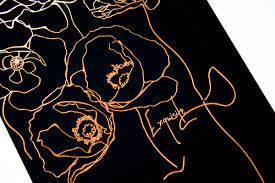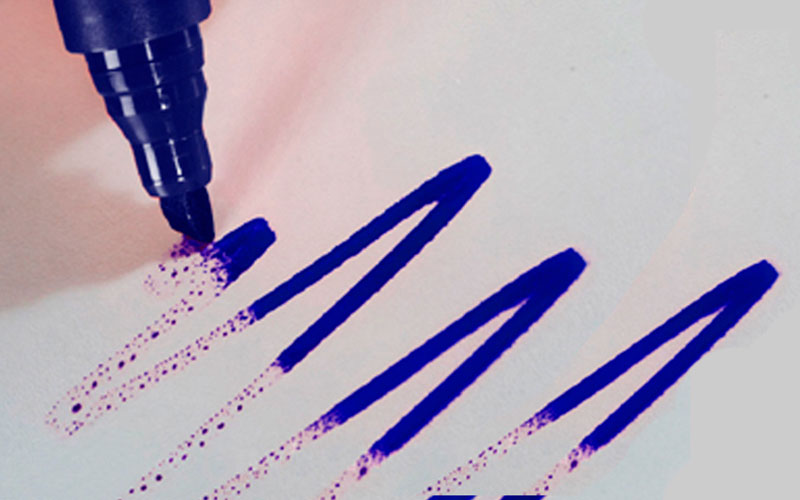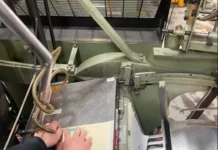Compiled by PostPress Staff
Paper stocks and coatings usually are the culprits of potential challenges with foil stamping and embossing. Foil and/or embossing can be a smooth process when the proper stocks and coatings are used, but when there is not communication about the selection of stocks and coatings to match the foiling and/or embossing, roadblocks can occur.
Communication is the key to matching foils to the right coatings or paper stock. Greg Faddis, direct sales professional with UEI Group, which supplies dies and foils through Universal Engraving, Inc. and Infinity Foils, Inc., shared that the substrates chosen and the coatings used can pose problems. These problems especially occur when the print finisher plans a job with the expectation that the finishing will be applied to virgin or uncoated stock, but learns only when the job arrives for processing that a coated stock has been used. In addition, Faddis noted that pairing the stock with the correct foil is essential, especially when wide coverage is involved. “Fineline detail type is great, but when you get into the large panels and it’s on a coated sheet, air entrapment becomes an issue,” he said. To avoid these kinds of surprises and problems, “We encourage our customers to send us a sample of their sheet, or we can supply samples of our foils for the customers’ own testing. We also have worked with paper suppliers, arranging for them to send us developmental products to test before they hit the market.”
Sean Hurley, vice president of sales for MCD, Inc., a Madison, Wisconsin-based print finisher, added his own take on problematic coatings. “We definitely have seen challenges,” he said. “A lot of soft touch is being used inline, and it seems to never be the same. You would like to say that soft touch is soft touch, but that is not necessarily the case because different printers have different chemistries.” Hurley also has seen challenges posed by inline specialty coatings. “We benefit from doing offline UV coating because we understand the coating side, which then helps us deal with challenging coating-related issues,” he explained.
Dave Leyrer, finishing department manager with Orlando, Florida-based SunDance, echoed that soft-touch coating and laminates can be problematic. “Everybody seems to just love the soft touch, which is great,” Leyrer said, “but it can be pretty challenging to foil stamp on, whether it is a laminate or coating. It seems like we will use a coating on one job and it works beautifully, and three days later we will coat another job with the same coating and we have issues. It’s daunting to try to figure out what exactly the right combinations are.” Suppliers, however, are introducing coatings and laminates that work better with foil stamping. “The soft touch in particular has become much, much better,” he said. “One vendor has come out with a soft touch plus, and it is wonderful for applying coatings and also for foil.”
Derrick Unger, field service manager for BOBST North America, was asked if he has seen soft-touch coatings create challenges on larger platen presses. “The first time I ever ran into soft touch, it was a coating and not a laminate,” said Under, “it blew my mind because it felt exactly the same as the lamination.” While he hasn’t seen specific problems with soft touch, he pointed out that coating, in general, is an element that requires thorough understanding and close attention. “As far as the coating aspect goes, along with UV coating and over-stampable UV coating, what I see most is cross-contamination.” This occurs, he said, when proper cleaning has not been done between jobs or during coating changes. Unger would like to see coating companies and print press manufacturers collaborate to provide training on crossover and change-out of coatings so that cross-contamination is avoided.
Faddis noted that his team always uses a dyne pen to test whether a substrate will accept foil stamping. This device can be sourced online by searching for a dyne surface energy testing pen. “The minimum dyne pen level that we have found to accept foil is a level 38,” said Faddis. “It is important to do a dyne test because then you know what coatings will accept foil or won’t accept foil.” This is a great insurance policy to check that a coating is foil stampable.
Saving a Job
There are many times that a UV-coated foil stamping job comes to the print finisher and there was no communication between the printer and finisher in using the correct coating. Leyrer recommended that print finishers carefully pair coatings with compatible paper stocks. “In careful selection of the coating,” Leyrer said, “you want to work closely with your coating manufacturers and your paper manufacturers to make sure you are using products that are compatible with each other.” That, however, isn’t the end of it. “There always is a lot of testing involved at the final stage in production,” he said. “And keep really good notes on your testing; it is very useful for future jobs.”
Unger offered a method for saving a hot foiling job when the substrate unexpectedly is difficult to stamp with a coating on it. “For some coatings and surfaces, a way to break the surface tension is to use good old 400-grit sandpaper,” said Unger. This method involves putting a piece of sandpaper over the die area, running the sheets through with the sandpaper in place, then removing the sandpaper and running the sheets through again to add foil. “In order to save the job,” said Under, “you have to run it twice but many, many times that does work.”
“Another option to break up the surface tension of the sheet is by using a corona treater, although that’s more common in the label industry than it is in sheet-fed,” stated Faddis. Some finishers have a corona treatment tower on their press, and this allows them to fracture the coating to create pores, which will allow the foil to stick.”
MCD’s Sean Hurley weighed in on the issue: “We foil stamp over the top of UV coatings on a regular basis. We work closely with printers to make sure they are using coatings that are considered glueable and stampable, and they understand the importance of handling the coatings properly. A good press cleaning is critical in preventing contamination.” Hurley described how his team proceeds with problem coatings. “When we see a job where the dyne level is low, say a level of 32, we try to bring the dyne level up so we can get the foil to stick,” he said. “One way to do that is to try corona treating the sheets. We also might try to flash sheets to get the surface energy to change. If we find that the dyne level is very low to start, we know that the wrong UV was used or somehow contaminated. At that point, we will definitely look for a foil that is manufactured for UV coatings, apply corona treatment, or do something with a sandpaper pass.”
Substrate Tips
Today, there are a large variety of substrates on the market, including coated, uncoated and synthetic papers, as well as plastics sheets and film.
Faddis shared a simple tip when testing a stock for embossing. “Take the corner of the substrate, fold it against itself and let it fall back,” he said. “If it falls back past a 90-degree angle while trying to return to its original state, the stock’s ‘memory’ is weak and it is something that will not hold the embossing well.” He explained that any stock that stays closer to where it was folded to – less than a 90-degree angle – is a substrate that will accept embossing very well.
“As for foil stamping,” Faddis continued, “it is one of those things where it has to be tested.” Faddis noted that stocks with a high cotton content are difficult to successfully foil stamp. “It’s very soft, it’s very airy,” he said, “and so when you stamp it – or any textured substrate – you are trying to get a level foil stamp. With any substrate that has a lot of hills and valleys, I would try and stay away from it, only because you are not going to get a consistent look. The higher portions are going to look great, but on the lower portions the foil is going to easily come off because it is not completely foil stamped in the valley area of the substrate.”
“In reference to those valleys,” said Unger, “with certain linen stocks, I’ve seen them be inconsistent. You really have to smash them pretty hard to bring the top layer to a flat level when flat stamping. You still get to see that texture in the sheet.” Unger also noted that paper stock is dramatically affected by the environment. The relative humidity of a paper stock, for example, starts at a certain level in the pulp factory, but depending on its transport, where the rolls of paper are stored and sheeted, and the finisher’s in-house climate control, the humidity level might change radically and repeatedly. Maintaining a consistent environment for paper stock leads to a better result.
In Leyrer’s experience, “Every time somebody hands me a stock that feels velvety, like soft touch, I kind of shiver a little bit.” His company has had bad experiences with some stocks that were just not right for the job. “With a stock like Neenah’s Touche®, you can’t really foil stamp with a combo die or do a foil emboss on it; it doesn’t work very well,” stated Leyrer. “But you can flat stamp it and then emboss it and it works beautifully.”
There are certain cover stocks, especially those that have a leather-type look, that may obtain plasticizers that can cause problems with the foil a few months after the foil stamping. “We had real challenges getting foil to lay down on a cover stock, and we thought we finally got it working,” explained Leyrer. “But three months later, when we looked back at the product, the foil had bled out – the pigment had bled out into the materials.”

Hurley agreed that Touche® can be a tough substrate to work with, but it is foil stampable with the right foil and makeready. “Another stock like Touche® is Plike®, which has a plastic-like surface and can create challenges with foil,” stated Hurley. “We also have seen some of the translucent stocks be problematic with embossing and foil stamping.”
It is important for foil stampers to stay abreast of new stock offerings and novel ways to use traditional stocks. Communicate with vendors and suppliers to learn about their products’ strengths and weaknesses. Then communicate with printers so that they understand the possibilities and limitations of the stocks so they provide complete descriptions of materials they are supplying for finishing. In addition, avoiding difficult stocks when possible also can help a foil stamping job go smoothly.
Lastly, the best advice for both paper stocks and coatings is to test all processes before the final production run. Of course, this is not always possible, but when time allows, testing first can save an enormous number of headaches down the road.
This article was based on a panel presentation – “Working Through Challenges with Today’s Paper Stocks and Coatings,” – which was part of FSEA’s Online Spring Summit in the summer of 2021. Thank you to panel members Greg Faddis, Universal Engraving, Inc.; Sean Hurley, MCD, Incorporated; Dave Leyrer, SunDance and Derrick Unger, BOBST.





